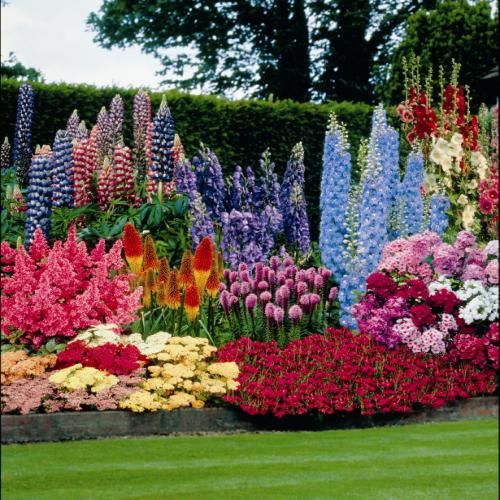Plant a Perennial Flower Garden
Timing for Planting
If you live in U.S. Department of Agriculture plant hardiness zone 7 or lower, then plant perennials in fall one month before your area's average annual first frost date, or plant in spring after the region's average annual last frost date. You can also plant a new perennial flower garden during summer.
If you are in the mild USDA zones 8 and higher, you can plant perennials any time of the year, but the ideal times are late fall, winter and early spring, when the combination of cool air temperatures and rainfall helps new plants become established fast.
TipSite Selection
When you want to plant in summer, wait for an overcast day, regardless of the USDA zone. Alternatively, plant in the morning or evening when the air temperature is cool. Putting tender new perennials in a garden on a hot day can stress them, making it harder for the plants to adapt to their new growing conditions.
The best site for your garden depends on the kinds of flowering perennials you intend to plant. Many perennials need full-sun exposure, but some thrive in partial shade, partial sun or full shade. Consider partial shade and partial sun any area that gets two to six hours of direct sunlight per day. Full sun means at least six hours of direct sunlight per day, and shade or full shade is a spot that gets fewer than two hours of direct sunlight daily.
Bed Arrangement
Plan to put tall flowering perennials toward the back of a flowerbed that borders a garden or fence. If the garden is free-standing in the landscape, then plant to place the tall perennials in the center. Small perennials should be toward the garden's front to create a border area. Mid-size perennials should be between the tall plantings and the small plants in the border area, helping with the transition between their heights.
Preparation and Planting
Step 1: Prepare the Soil
Spread compost or manure 2 to 3 inches deep across the surface of the cleared garden bed. Turn over the soil to a depth of 12 inches, mixing it with the compost by using a garden fork or tiller.
Step 2: Add Fertilizer
Add a slow-release, granular, 10-10-10 fertilizer to the soil surface, and incorporate it with the soil to a depth of 12 inches. Use 1 1/2 cups of the fertilizer for every 50 square feet of soil surface. A 5-by-10-foot garden bed is 50 square feet.
Step 3: Dig Planting Holes
Dig holes 18 inches apart in the prepared garden bed. Make each hole the same depth as the nursery pot of the perennial plant you will put in the hole.
Step 4: Prepare the Plants
Tip a plant's nursery pot on its side, and gently wiggle the plant out of the pot. Rough up the outside of the plant's root ball with your hands. Identify the roots that grow around the root ball, and pull them gently outward. Set the root ball in the planting hole designated for that plant. Add soil to the hole or dig the hole a little deeper until the base of the plant's stems line up with the soil level of the ground surrounding the hole. Repeat the process for each plant.
Step 5: Fill the Holes
Push soil around each plant's root ball up to the base of the stems. Smooth the soil around the newly planted perennials.
WarningAfter-Planting Care
Don't plant perennials too deep or their stems could rot under the soil. Planting too shallow, however, can cause top roots to dry out.
When you finish planting, water the garden's soil to settle the roots in the soil. Water slowly and deeply until the bed is damp 12 inches deep. Keep the soil damp for the first two weeks after planting the perennials. Add a layer of mulch 2 inches deep on the new garden. Use leaf mold, compost, shredded bark or fine wood chips as mulch. Mulch helps keep the soil moist and makes for a tidy appearance while the new plants grow in the perennial flower garden.
Tip
Give plants a little breathing room when adding mulch by keeping it about 3 inches from the base of the plant stalks. Doing so helps minimize rot problems.












Comments
Post a Comment